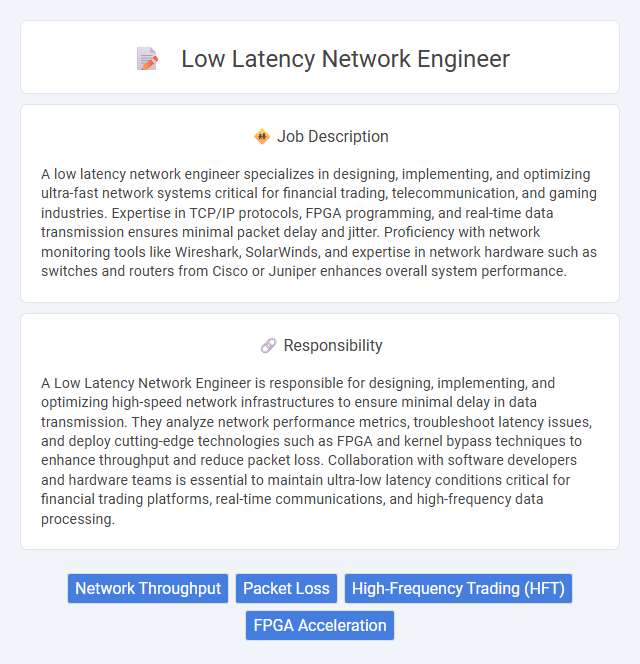
A low latency network engineer specializes in designing, implementing, and optimizing ultra-fast network systems critical for financial trading, telecommunication, and gaming industries. Expertise in TCP/IP protocols, FPGA programming, and real-time data transmission ensures minimal packet delay and jitter. Proficiency with network monitoring tools like Wireshark, SolarWinds, and expertise in network hardware such as switches and routers from Cisco or Juniper enhances overall system performance.
Low latency network engineering likely suits individuals who excel under pressure and possess strong analytical skills, given the need for rapid problem-solving in high-stakes environments. People comfortable with continuous learning and adapting to cutting-edge technology probably find this role rewarding and engaging. Those who prefer routine tasks or less stress may find the fast-paced nature of this job challenging.
Qualification
A Low Latency Network Engineer requires in-depth knowledge of high-frequency trading environments, proficiency in network protocols such as TCP/IP, UDP, and multicast, and hands-on experience with fiber optics and network hardware tuning. Strong skills in programming languages like C++ or Python for network automation and optimization are essential, alongside expertise in Linux systems and real-time data processing. Certifications like CCNP, JNCIA, or relevant FPGA and kernel development experience significantly enhance a candidate's qualification for this specialized role.
Responsibility
A Low Latency Network Engineer is responsible for designing, implementing, and optimizing high-speed network infrastructures to ensure minimal delay in data transmission. They analyze network performance metrics, troubleshoot latency issues, and deploy cutting-edge technologies such as FPGA and kernel bypass techniques to enhance throughput and reduce packet loss. Collaboration with software developers and hardware teams is essential to maintain ultra-low latency conditions critical for financial trading platforms, real-time communications, and high-frequency data processing.
Benefit
Low latency network engineers are likely to enhance system performance by minimizing data transmission delays, which is critical for industries relying on real-time information such as finance and gaming. Their expertise might contribute to improved user experiences and increased operational efficiency by ensuring rapid data processing and transmission. Employers could possibly see a competitive advantage through faster, more reliable network infrastructures designed and maintained by these specialists.
Challenge
Low latency network engineer roles likely involve complex challenges related to minimizing data transmission delays in high-frequency trading or real-time communication systems. Engineers in this field may need to optimize network hardware and protocols to achieve near-instantaneous data processing and delivery. Balancing speed with reliability and scalability could present ongoing technical obstacles requiring innovative solutions.
Career Advancement
Low latency network engineers specialize in designing and optimizing high-speed communication systems for financial trading, telecommunications, and gaming industries, where milliseconds impact performance. Mastery of technologies such as FPGA programming, kernel bypass techniques, and protocol optimization drives career progression into senior engineering roles, architecture, or specialized consultancy. Continuous skill enhancement in emerging network protocols and real-time data processing significantly boosts opportunities for leadership positions and higher compensation.
Key Terms
Network Throughput
A low latency network engineer specializes in optimizing network throughput to minimize delays and maximize data transfer speeds across trading platforms, data centers, and high-frequency trading environments. They implement advanced techniques such as traffic shaping, protocol optimization, and hardware acceleration to ensure efficient packet processing and reduced jitter. Expertise in monitoring tools like Wireshark and SolarWinds is essential for identifying bottlenecks and enhancing overall network performance.
Packet Loss
Low latency network engineers specialize in minimizing packet loss to ensure high-speed, reliable data transmission across financial trading platforms and real-time applications. Expertise in optimizing network protocols such as TCP and UDP, along with advanced knowledge in quality of service (QoS) configurations, helps to reduce jitter and improve overall packet delivery efficiency. Proficient in using traffic analysis tools like Wireshark and network performance monitoring systems, these engineers identify and resolve bottlenecks that cause packet loss and latency spikes.
High-Frequency Trading (HFT)
Low latency network engineers specializing in High-Frequency Trading (HFT) optimize ultra-fast data transmission systems to minimize delays in financial transactions. Expertise in FPGA programming, kernel bypass techniques, and colocated data centers enhances execution speed critical for real-time market data processing. Proficiency in TCP/IP stack tuning, protocol optimization, and hardware acceleration ensures superior trade execution and competitive advantage in volatile trading environments.
FPGA Acceleration
Low latency network engineers specializing in FPGA acceleration design and optimize hardware-based solutions to minimize data processing delays in high-frequency trading and real-time communication systems. They implement custom FPGA logic to accelerate packet processing, reducing latency to microseconds by offloading tasks from CPUs and enhancing throughput. Expertise in Verilog, VHDL, and network protocols such as TCP/IP and RDMA is critical for achieving ultra-low latency performance and maintaining reliable system operations.
 kuljobs.com
kuljobs.com